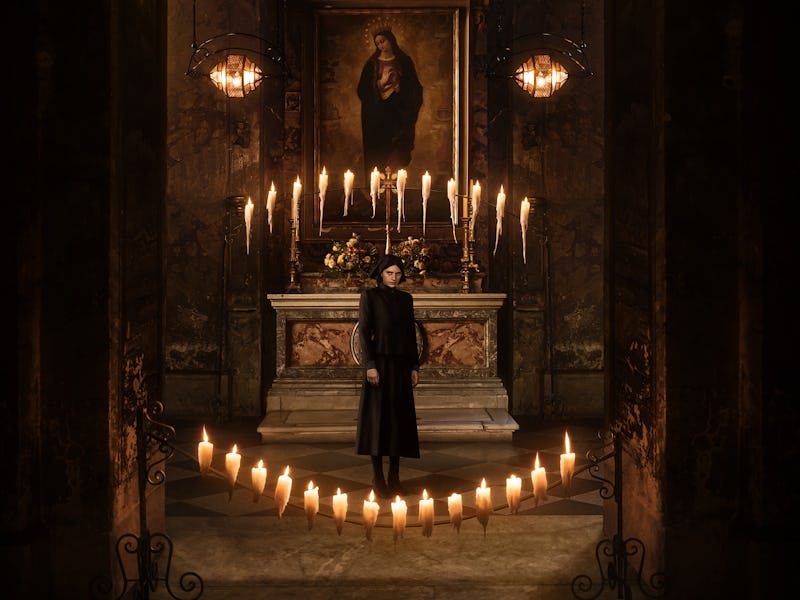The First Omen Shows How to Make a Great Horror Prequel
All hail this unsettling new prequel.

“It’s all for you.” Those four words are perhaps best known as a devilish promise from protector to Antichrist, but now, they can also be seen as a heartfelt dedication from director Arkasha Stevenson to fans of the beloved horror series she took up the helm of. The First Omen, a prequel entry to the 1976 original, is an engrossing trip into the dark heart of evil and what it means to be chosen by the cruel hand of fate — and surprisingly, it lives up to the strength, power, and overarching dread of its source material.
The First Omen follows Margaret (Game of Thrones’ Nell Tiger Free), an American girl who comes to work at a Roman orphanage run by the church before taking her vows to become a nun. There she discovers an earth-shattering conspiracy to unleash the Antichrist upon the world — as well as her own mysterious and irrevocable part in it all.
Nell Tiger Free is phenomenal as a young nun wrestling with the church’s sins.
This new entry builds a truly terrifying view of the church that is both on par with the subgenre’s past as well as its contemporaries (cough, Immaculate, cough) while also maintaining its own singular identity, the one The Omen franchise was imbued with nearly 50 years ago. Between the pitch-perfect glimpses of the film’s central monster and Margaret’s encounters with her sinister side — among many other moments it would be wrong to spoil — Stevenson’s origin story definitely delivers on the overwhelming sense of trepidation the franchise is known for. The film employs purposeful and satisfying callbacks to the original, and even to horror masterpieces like Andrej Zulawski’s Possession. These callbacks, along with a great sense of temptation within the story, feel integral to the overall success of Stevenson’s unsettling efforts.
To that end, the film wouldn’t be nearly as successful without Aaron Morton’s cinematography, whose every shot feels rife with intention. There is a strong sense of composition in these shots, strengthening the feeling that both director and DP are working collaboratively to achieve the tonal landscape necessary to sustain the story.
Director Arkasha Stevenson shows a clear reverence for the original film, and horror in general, with her striking directorial vision.
It’s not every day that you see such memorable shots that not only read as beautiful or striking but also push the plot along so clearly and serve an obvious purpose. There are so many scenes where this feeling rings true: the opening moments involving a stained glass window, the shot of a spider on Margaret’s eyelashes, her hair splayed out on her pillow as she’s framed from above, a magnetic close-up of her petrified eye, the frantic camera flying over the city of Rome. Both artists are obviously compelled to find the aesthetics within the horror at play, and it’s always nice to see that kind of effort in the genre, especially when achieved so well.
Much of the film’s visual language — on top of, of course, its literal plot and dialogue — is a conduit to the notions of confronting both fervent idolatry and the natural progression to secularism, which, needless to say, feels very current. While the movie doesn’t offer any solutions, as the inciting incident of the Omen story, it’s not there to do so either. Much of the religious horror with a basis in Catholicism is concerned with showing religion as the, pun intended, savior. But the Omen films have always offered us another viewpoint, one that implicates the church as capable of real evil. This entry is no exception, and through the intelligence and the instincts of the protagonist, we’re shown another side of the faith that feels hauntingly plausible.
The First Omen wouldn’t work without Nell Tiger Free’s guileless performance.
Naturally, the final piece of the puzzle for this film is Free’s performance, which hits all the right notes as her journey progresses. Margaret is exactly as demure and delicate as you’d picture a young nun to be, but she also radiates with a warm kindness that is crucial to the complicated character. She feels very much like someone you can trust, and her openness bleeds into a naivety that ultimately forces her into a true reckoning with the supernatural and her faith. It’s a layered performance in which Free makes a concerted effort to show the audience Margaret’s emotional arc. On the other hand, her physical acting is just as strong, entirely believable in her struggle to maintain sanity, clarity, and control. Both sides of the performance complement each other, giving way to a fully realized character who seamlessly becomes the foundation of the audience’s investment.
The First Omen may, at first glance, seem like any old cash grab entryway to reviving a dead franchise for shareholder benefit. Lord knows we’ve seen enough of that these days. But this time, we’ve got ourselves a new take on a classic that feels truly at home with the story it’s slotting itself into. Stevenson approached this film with a clear reverence that feels almost holy — if only many other modern sequels, prequels, or requels could say the same.